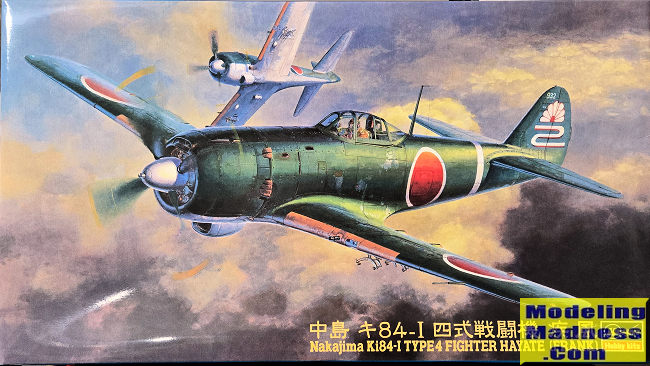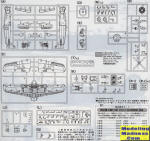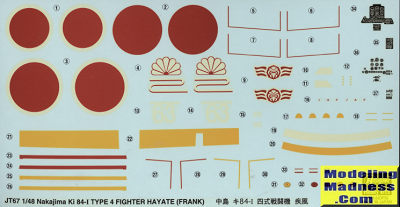
Hasegawa 1/48 Ki-84-I 'Hayate'
| KIT #: | 09067 (Jt67) |
| PRICE: | 2000 yen when new |
| DECALS: | Two options |
| REVIEWER: | Scott Van Aken |
| NOTES: | 1999 release |

| HISTORY |
| THE KIT |
 Prior
to this kit's release in 1999, the only other options for a Ki-84 were kits by
Otaki and Tamiya. Tamiya's offering was (and still is despite be marketed as
1/48) their 1/50 kit. Tamiya produced theirs back in a time when they were
trying to make 1/50 a standard scale. In fact Japan's Koku Fan monthly aviation
magazine used to have profiles and plans in 1/50 scale to help spur interest.
This kit from Hasegawa was much welcomed by modelers and was part of Hasegawa's
major production spurt of the 1990s when they released a lot of new tool kits
into the market.
Prior
to this kit's release in 1999, the only other options for a Ki-84 were kits by
Otaki and Tamiya. Tamiya's offering was (and still is despite be marketed as
1/48) their 1/50 kit. Tamiya produced theirs back in a time when they were
trying to make 1/50 a standard scale. In fact Japan's Koku Fan monthly aviation
magazine used to have profiles and plans in 1/50 scale to help spur interest.
This kit from Hasegawa was much welcomed by modelers and was part of Hasegawa's
major production spurt of the 1990s when they released a lot of new tool kits
into the market.
The kit was the best yet available in this scale and due to a lack of modern competition, it still is. You get a well appointed cockpit that really only needs to have a seat harness as there is a lot of detail on the floor and the sidewalls. Since the cockpit assembly installs on pins which fit into sockets in the fuselage sides, you must install it when you close the fuselage halves. Something Hasegawa tried on this kit is to use polycaps to hold in all the landing gear so you need to be careful not to forget these items. They are also used for wing pylons and the prop. There are two sizes so be sure to use the correct ones.
With the wings assembled, they and the tailplanes are glued in place. Construction then moves to the landing gear. You can leave those off until after painting. The engine assembly is especially well done and fits onto a firewall over which a close cowling fits. Next step will have you install the landing gear and doors, but again, I'd hold off until after painting. Attention then goes to the bomb racks, gun barrels and other bits that are easy to break free during handling. The kit has separate flaps and these are designed to be posed open. As is frequently the case, these items were rarely open on the ground so you might want to see if you can modify these to fit closed. There is a separate canopy so that might be able to be posed open.
 Instructions
are well done and use Gunze paint references. Two markings options are provided,
both in Nakajima dark green over light grey. One is the box art plane with the
22nd Flight Regiment. This one has a white spinner. The other is with the
Hitachi Training Flight Division. Decals are 'old school' and despite their age,
will probably work just fine with hot water. There are, of course, a number of
aftermarket sheets for the Ki-84.
Instructions
are well done and use Gunze paint references. Two markings options are provided,
both in Nakajima dark green over light grey. One is the box art plane with the
22nd Flight Regiment. This one has a white spinner. The other is with the
Hitachi Training Flight Division. Decals are 'old school' and despite their age,
will probably work just fine with hot water. There are, of course, a number of
aftermarket sheets for the Ki-84.
| CONCLUSIONS |
This is the initial offering and base boxing of this kit. I built one shortly after it came out and the only real issue I had was with the plastic poly caps for the landing gear. They made the gear a bit wobbly and I ended up breaking both legs where they fit into the poly caps. One thing I noticed is that the use of polycaps for landing gear was short lived at Hasegawa with only a few kits using this method. That aside, it makes into a very nice model and is one that is easily found
| REFERENCES |
https://en.wikipedia.org/wiki/Nakajima_Ki-84
August 2024
Copyright ModelingMadness.com. All rights reserved. No reproduction in part or in whole without express permission from the editor.
If you would like your product reviewed fairly and fairly quickly, please contact the editor or see other details in the Note to Contributors.